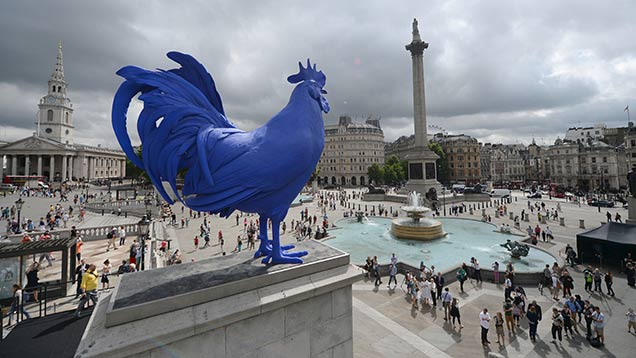How the chicken crossed the world
 © Rex
© Rex A new book tracing the history and cultural significance of the chicken makes for thought-provoking reading, as Jake Davies discovered when he met author Andrew Lawler.
“Add up the world’s cats, dogs, pigs and cows and there would still be more chickens. Toss in every rat on earth and the bird still dominates.” The first line of Andrew Lawler’s new book, Why did the chicken cross the world? highlights just how important to the global diet is the humble chicken.
At any given moment, there are 20 billion chickens on the planet, and only two countries with no poultry: Antarctica, because of strict biosecurity and Vatican city, where it is only a short journey to Rome’s supermarkets to pick some up. Nasa has even studied the possibility of bringing chicken along when it travels to Mars.
Mr Lawler argues it is our most important animal partnership, and one made possible by the genetic malleability of the bird. No other species can adapt so well to different environments or be bred to such specification.
A central theme to the book is the development of the modern poultry industry, but it jumps through time and topics to deliver a rounded history of chicken.
The final chapters offer his outsider’s view on the modern industry – and highlight how difficult he found gaining access to American poultry farms and industry representatives, well before avian influenza was an issue.
Multiple roles
The book isn’t restrained to the value of chicken as a source of food, however. It covers the bird’s role in medicine, vaccines, superstition, religion and “possibly the second oldest spectator sport” – cockfighting. Indeed, Mr Lawler’s research suggests that poultry has been considered a deity almost as often as dinner.
 While there had been around five “small, scrawny and ill-tempered” varieties of bird on the British Isles for hundreds of years, it was regal enthusiasm that kick-started the UK’s love of poultry – and the breeding programmes that foreshadowed the modern industry.
While there had been around five “small, scrawny and ill-tempered” varieties of bird on the British Isles for hundreds of years, it was regal enthusiasm that kick-started the UK’s love of poultry – and the breeding programmes that foreshadowed the modern industry.
In 1842 Queen Victoria delighted over the gift of exotic animals, no less so than five hens and two cocks of a variety never seen in the UK.
They were thought to be Malaysian, and were far different to the native breeds, such as the Dorking. Fatter, more refined and colourfully feathered, it wasn’t long before royals across Europe were collecting fancy fowl, interbreeding them and creating new examples. One newspaper correspondent dared to suggest that the new breeds could, “in the course of time, cause much improvement to the stock of our native species”.
Better breeding
A similar movement was taking place in the US, with rare breeds changing hands for hundreds of dollars. Collectors began selecting birds for more eggs, or meatier, larger breasts. The Plymouth Rock was first shown in 1849 and combined the genes of English Dorkings with Asian Cochins and Malays. It soon spread worldwide.
We also learn about early farming from African American slaves, who were permitted to keep poultry – and became specialists in trade and breeding. By the time of the Civil War, they had been rearing poultry for more than two centuries. Jewish settlers in New York also fuelled a huge demand for chickenmeat.
We learn it is women who are the earlier pioneers of poultry production in the US. A lady named Celia Steele is credited as being the first to raise chickens purely for meat. It heralded a huge expansion and the beginning of broilers as we know them today.
Mr Lawler argues that, once the profitability of such farming had been established, it soon became the preserve of white men, who sought to drive ever-greater efficiencies.
One example is the “chicken of tomorrow”, a US competition in the 1950s to breed more efficient meat-producing birds. “The award marked the rise of a vast new industry… The bird was chosen not for its exotic stature or pure breeding, but its similarity to a wax carcass as devised by a team of poultry scientists.”
Modern systems
From here, Mr Lawler focuses on the part poultry played in the rapid productivity gains rolled out across farming during the so-called Green Revolution. But it is not a welcome change, in his eyes. “There had been nothing like this in human history. There is no record of any other major food – meat, dairy, grains, fruits or vegetables – expanding so quickly in volume and scale.”
He describes a new generation of poultry “magnates”, happy to draw on scientific advances in contrast to more traditional farmers. John Tyson, the founder of the largest meat company in the world, gets special mention as a pioneer of the vertically integrated supply chain.
 Mr Lawler has spent three years examining the cultural, social and economic history of chicken and concluded that it has become an “industrial machine”, a status at odds with its position as human’s most important animal partnership.
Mr Lawler has spent three years examining the cultural, social and economic history of chicken and concluded that it has become an “industrial machine”, a status at odds with its position as human’s most important animal partnership.
It is a conclusion anyone working in the poultry industry should be mindful of.
*Why did the chicken cross the world? is published by Duckworth Overlook.
